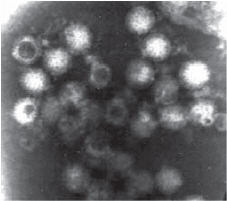



Avian Reovirus Infections
By F. Dustan Clark, Extension Poultry Health Veterinarian at the University of Arkansas's Avian Advice - Reoviruses are widespread in nature and have been isolated from a variety of animals. These viruses have also been isolated from humans and in fact the name reovirus is a mnemonic for respiratory (r) enteric (e) orphan (o) since the virus was isolated from the human respiratory and enteric tract, but was not associated with disease. In some species of mammals (primarily mice) these viruses have caused liver, pancreatic, lung, and heart disease and central nervous system symptoms.| More on the Author | |
| Dr. Dustan Clark Extension Poultry Health Veterinarian |
|
Introduction
Avian reoviruses, in the past, have been associated with viral arthritis/tenosynovitis, malabsorption syndrome, stunting/runting syndromes, enteric disease, immunosuppression, and respiratory disease. Recently, there have been reports from the field and isolations of reoviruses from chickens exhibiting neurological signs.
Avian Reovirus Diseases
 Viral Arthritis - Reoviruses were first isolated from chickens in 1954. This isolate (Fahey-Crawley) produces viral arthritis/tenosynovitis when inoculated into chickens. In field situation viral arthritis is seen primarily in meat type strains of chickens, but has been reported in egg type chickens and in turkeys. While birds are usually affected with the disease at 4-8 weeks of age, older birds can also be affected naturally and younger birds experimentally. As would be expected, birds with the disease, varying degrees of lameness is a typical sign of the disease. Some birds may also be stunted in size. The lesions observed are swelling and inflammation of the hock joint and tendon sheath with a yellow colored fluid present in the hock.
The fluid may be tinged with blood or occasionally it contains purulent (pus) exudate. As the inflammation progresses over time; scar tissue forms and may fuse tendons and sheaths together. Bones of the joint may also become eroded or pitted And rupture of the gastrocnemius tendon may be present.
Viral Arthritis - Reoviruses were first isolated from chickens in 1954. This isolate (Fahey-Crawley) produces viral arthritis/tenosynovitis when inoculated into chickens. In field situation viral arthritis is seen primarily in meat type strains of chickens, but has been reported in egg type chickens and in turkeys. While birds are usually affected with the disease at 4-8 weeks of age, older birds can also be affected naturally and younger birds experimentally. As would be expected, birds with the disease, varying degrees of lameness is a typical sign of the disease. Some birds may also be stunted in size. The lesions observed are swelling and inflammation of the hock joint and tendon sheath with a yellow colored fluid present in the hock.
The fluid may be tinged with blood or occasionally it contains purulent (pus) exudate. As the inflammation progresses over time; scar tissue forms and may fuse tendons and sheaths together. Bones of the joint may also become eroded or pitted And rupture of the gastrocnemius tendon may be present.
Mal-Absorption / Pale Bird Syndrome - Reoviruses have also been isolated from birds with
mal-absorption/mal-digestion/pale bird syndrome. Affected birds are stunted, unthrifty, have poor
feed conversions and generally look sick. Orange tinged diarrhea may be present as can be various
degrees of diarrhea and mal-digestion. Some birds may lose color in the legs and beak while others may have various feather problems. Mortality is usually low although numerous birds can be affected. This condition is usually seen between 3-6 weeks of age and is usually observed in meat type chickens.
Neurological Signs - The newest reported problem in chickens associated with a reovirus is neurological signs, which may include: incoordination, tremors, twisted necks, or twitches. The affected flocks have also had signs of arthritis/tenosynovitis and malabsorption. The condition has been reported in broiler breeder replacement pullets in the United States. In Europe a new
reovirus was isolated which caused neurological signs when injected into Specific Pathogen Free Leghorn chickens.
Diagnosis and Prevention
Viral arthritis can be diagnosed presumptively by signs and lesions. Microscopic examination of the tendons and tendon sheaths, serological testing, or virus isolation can also be used. Mal-absorption is usually diagnosed based on clinical signs or virus isolation. These diseases can be prevented by vaccination. Since the virus can be carried mechanically it is important to utilize good biosecurity and cleaning/disinfection protocols to assist in prevention exposure of flocks. Fortunately, vaccination programs in breeder birds have helped to reduce the incidence of this disease in progeny. As new isolates are found, research efforts to provide better more efficacious vaccines are continuing.
Summary
Avian reoviruses are widespread in nature and are known to cause viral arthritis and malabsortion
/ pale bird syndrome. However, recent field reports have associated the virus with neurological signs. Vaccination of breeder birds as well as strict biosecurity procedures can effectively reduce the effects of reoviruses on commercial poultry flocks.

Source: Avian Advice - Fall 2003 - Volume 5, Number 3








